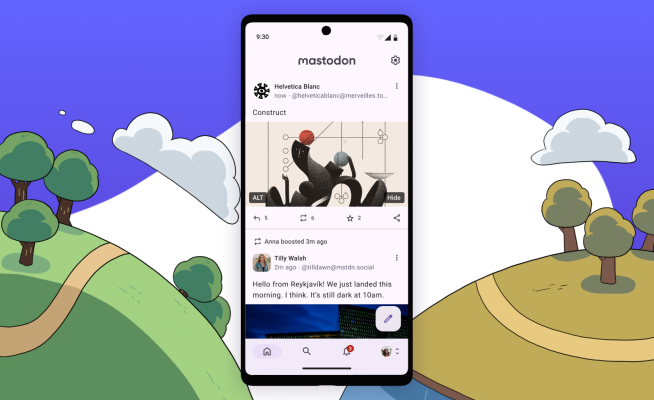While Twitter is busy limiting the number of readable tweets and breaking its TweetDeck app, open source Twitter alternative Mastodon is celebrating the launch of a significant refresh of its Android app. The new app, released over the weekend, features a complete Material You redesign — Google’s design language for Android — as well as revamped features such as tab bars, settings, a compose screen, and more.
Mastodon founder and CEO Eugen Rochko shared news of the update on the Mastodon blog, as the social network — including its mobile apps, web version, and third-party clients — now reaches an active user base of 1.4 million monthly active users according to the company’s own data. That monthly active figure is up 19%, the website also notes, but is down from Mastodon’s peak popularity in the wake of Elon Musk’s Twitter takeover late last year, when it had then seen 2.5 million monthly users.
Today, Rochko shared that the number of active users across Mastodon rose by 294,000 over the weekend, and posting activity roughly tripled — figures likely tied to Twitter’s troubles.
According to Rochko, the new Android app out now features dozens of ways to customize the user experience in the new settings screen, ranging from being able to change the default posting language, to reminding yourself to add alternative text for your media uploads, to being able to hide the “boost” and “favorite” counters — the former, Mastodon’s version of Twitter’s retweet.
Android users can also access information about the server they’re connected to and view its rules. (In Mastodon’s decentralized social network, users join a server that is connected — or federated — with other servers across the wider network, and each server has its own admin(s) and moderation guidelines.)
In addition, the Android app’s refreshed user profile section will now display all the featured content that was previously missing from the app, Rochko notes, including things like pinned posts, featured hashtags, and endorsed users.
Plus, users can now filter Mastodon’s content by creating filters for phrases or keywords and then customizing when those filters should apply. Users can also temporarily pause notifications for those times when they want to take a break.
Another change is how the app displays verifications. On Mastodon, users can self-verify by placing a specific link on their website that points to their Mastodon profile, then edit their profile to add the link to their website. This doesn’t give them a “blue badge” as on other social networks, but verifies someone’s broader identity across the web.
Now, when profiles have a verified link, Mastodon’s app will surface it in the search results and in other lists so it’s easier to tell different profiles apart. This could help to address one of the complaints from users that finding notable people to follow on Mastodon is too difficult.
The refreshed app is available via the Google Play Store, but it’s not the only option for Android users. Other popular Android clients for Mastodon include Tusky, Megalodon, Fedilab, Tooot, and others. However, iOS users have a wider selection, including newer apps like Woolly, Mammoth, Radiant, and Ivory, which sprung up amid the Twitter exodus after Musk’s acquisition and API changes that put Twitter apps out of business. Because Android users have fewer third-party options, an update to Mastodon’s official mobile app on Android has a more significant impact than it would on iOS.
